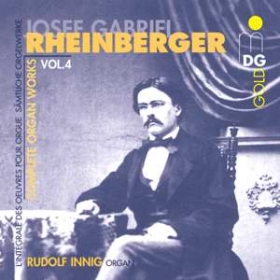
MDG 317 0894-2
Rudolf Innig, Orgel
Walcker Orgel Stadtkirche Winterthu
Josef Rheinberger (1839-1901)
Complete Organ Works Vol. 4
Sonatas No. 7-8
Excerpts from the booklet
In the case of Rheinberger’s earlier sonatas we determined that his movement headings are not always reliable indicators of the particular movement type, and the same also applies to the seventh sonata. Rheinberger terms the first movement a Prelude in Allegro non troppo, but this movement, to which the secondary literature occasionally assigns five themes (Weyer, Grace), also contains elements of the sonata-form movement structure. The movement is framed by a tonally magnificent, typically preluding section, which of course occurs in slightly different form on its resumption at the conclusion. Rheinberger’s insertion of a dominant pedal point into what in sonata form would be understood as the first subject or theme serves as one example of his undogmatic treatment of the »themes.« He employs them not according to their function but in keeping with their melodic quality. The theme develops without a break from the introductory section the first time around and is integrated into the same in the conclusion in just the same way. (Dr. Irmlind Capelle)
Excerpts from the reviews
„Rudolf Innig versteht es meisterhaft, den melodischen Fluss dieser Musik gerade in den langsamen Sätzen auszukosten und den klanglichen Finessen der von ihm verwendeten Instrumente gerecht zu werden.“ (Musica Sacra, 2001)
„Für MDG sprechen neben der Ausstattung die kohärente Interpretation Rudolf Innigs und das umfassende Programm – die Edition geht chronologisch vor (auch in den Cover - Portraits), beginnend mit den Kompositionen des Zwölfjährigen, die Sonaten entsprechend der numerischen Reihenfolge.“ (FonoForum, 2001)
„Der vielfach ausgezeichnete Rudolf Innig hat sich der Gesamteinspielung von Rheinbergers Orgelmusik angenommen. Innigs Spielweise ist untadelig, er spürt dem Romantiker Rheinberger nach und lässt die Musik schwelgerisch fließen. Auf der herrlichen Orgel in Winterthur erscheint denn auch Rheinbergers vielleicht bedeutendstes Orgelwerk, die Sonate, in e – Moll op. 132 in bestem Licht. Das frühlingshafte Intermezzo lässt herrliche Flötenstimmen erklingen, und das für Rheinberger fast übermütige Scherzo fesselt durch seine rhythmischen Impulse. Die abschließende Passacaglia hält jedem Vergleich mit Regers f – Moll Werk stand.“ (Orgel International, 2002)
„As for me, for Rheinberger I am going to stick with Rudolf Innig. … Turning to Innig’s offering, I reviewed Vol. 3 in May 2001edition of ‘The Organ’, and was duly impressed by the player, the organ and the recording. I welcome this recording by Rudolf Innig, and indeed the whole series – to hear the music played on an instrument more or less contemporary with the works being played is an enlightening an stimulating experience. The recording quality is excellent.” (The Organ Magazine, 2001)
“Las lecturas de Rudolf Innig resultan incivas en lo structural y muy musicales.” (Scherzo, 2001)

